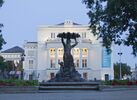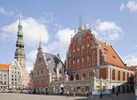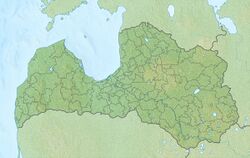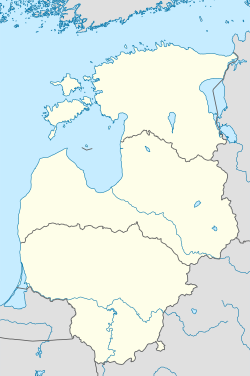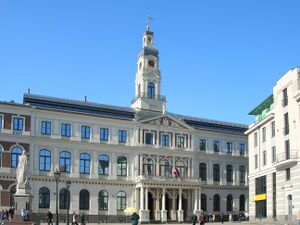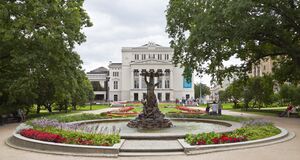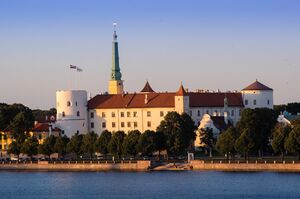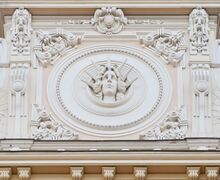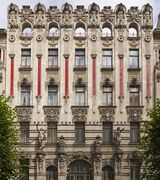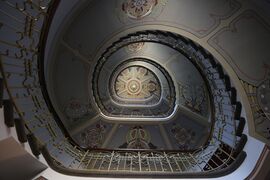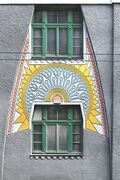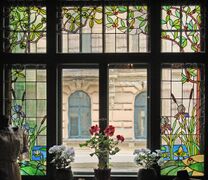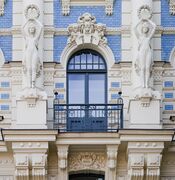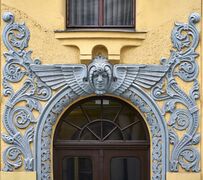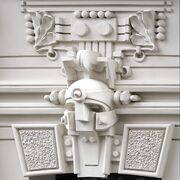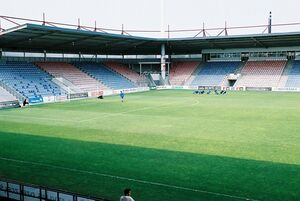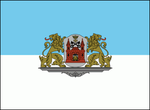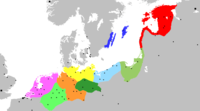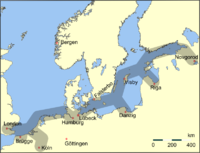ريغا
Riga
Rīga (لاتڤية) | |
|---|---|
Clockwise from top right: the Riga City Council building; the House of the Blackheads; Latvian National Opera; and Livonian Square | |
|
| |
| الإحداثيات: 56°56′56″N 24°6′23″E / 56.94889°N 24.10639°ECoordinates: 56°56′56″N 24°6′23″E / 56.94889°N 24.10639°E | |
| Country | Latvia |
| الحكومة | |
| • النوع | City Council |
| • Mayor | Vilnis Ķirsis[1] |
| المساحة | |
| • الماء | خطأ في التعبير: معامل مفقود للعامل -. كم² (Formatting error: invalid input when rounding ميل²) 15.8% |
| • العمران | 3٬359 كم² (1٬297 ميل²) |
| التعداد (2014) | |
| • Capital city and state city | 701٬977 |
| • Urban | 920٬643[3] |
| • العمرانية | 870٬000 |
| • الكثافة العمرانية | 260/km2 (670/sq mi) |
| • Demonym | Rigan (Rīdzinieks) |
| منطقة التوقيت | UTC+2 (EET) |
| • الصيف (التوقيت الصيفي) | UTC+3 (EEST) |
| Calling codes | 66 and 67 |
| Gross Regional Product(City) | 2020[5] |
| - Total | €16 billion |
| - Per capita | €25,925 |
| City budget | €1.26 billion[6] |
| HDI (2021) | 0.929[7] – very high |
| الموقع الإلكتروني | riga.lv |
| الاسم الرسمي | Historic Centre of Riga |
| النوع | Cultural |
| المعيار | ii, i |
| التوصيف | 1997 |
| الرقم المرجعي | [8] |
| UNESCO region | Europe |
ريگا (Rīga ؛ /ˈɹiːɡə/؛ باللاتڤية: [Rīga] Error: {{Lang}}: text has italic markup (help) [ˈriːɡa] (![]() استمع), Livonian: Rīgõ) هي عاصمة لاتڤيا وأكبر مدنها. تقع على ساحل بحر البلطيق عند مصب نهر دوجفا. وهي أكبر المدن بين مدن دول البلطيق، وتعتبر المركز الأساسي للثقافة، التعليم، السياسة، المال، التجارة والإقتصاد والصناعة لمنطقة البلطيق. and is home to 605,802 inhabitants[9] which is a third of Latvia's population. The population of Riga metropolitan area, which stretches beyond the city limits, is estimated at 860,142 (as of 2023). The city lies on the Gulf of Riga at the mouth of the Daugava river where it meets the Baltic Sea. Riga's territory covers 307.17 km2 (118.60 sq mi) and lies 1–10 m (3.3–32.8 ft) above sea level,[10] on a flat and sandy plain.[10]
استمع), Livonian: Rīgõ) هي عاصمة لاتڤيا وأكبر مدنها. تقع على ساحل بحر البلطيق عند مصب نهر دوجفا. وهي أكبر المدن بين مدن دول البلطيق، وتعتبر المركز الأساسي للثقافة، التعليم، السياسة، المال، التجارة والإقتصاد والصناعة لمنطقة البلطيق. and is home to 605,802 inhabitants[9] which is a third of Latvia's population. The population of Riga metropolitan area, which stretches beyond the city limits, is estimated at 860,142 (as of 2023). The city lies on the Gulf of Riga at the mouth of the Daugava river where it meets the Baltic Sea. Riga's territory covers 307.17 km2 (118.60 sq mi) and lies 1–10 m (3.3–32.8 ft) above sea level,[10] on a flat and sandy plain.[10]
Riga was founded in 1201 and is a former Hanseatic League member. Riga's historical centre is a UNESCO World Heritage Site, noted for its Art Nouveau/Jugendstil architecture and 19th century wooden architecture.[11] Riga was the European Capital of Culture in 2014, along with Umeå in Sweden. Riga hosted the 2006 NATO Summit, the Eurovision Song Contest 2003, the 2006 IIHF Men's World Ice Hockey Championships, 2013 World Women's Curling Championship and the 2021 IIHF World Championship. It is home to the European Union's office of European Regulators for Electronic Communications (BEREC). In 2017, it was named the European Region of Gastronomy.
In 2019, Riga received over 1.4 million foreign visitors.[12] The city is served by Riga International Airport, the largest and busiest airport in the Baltic states. Riga is a member of Eurocities,[13] the Union of the Baltic Cities (UBC)[14] and Union of Capitals of the European Union (UCEU).[15]
. . . . . . . . . . . . . . . . . . . . . . . . . . . . . . . . . . . . . . . . . . . . . . . . . . . . . . . . . . . . . . . . . . . . . . . . . . . . . . . . . . . . . . . . . . . . . . . . . . . . . . . . . . . . . . . . . . . . . . . . . . . . . . . . . . . . . . . . . . . . . . . . . . . . . . . . . . . . . . . . . . . . . . . .
أصل الاسم
There are numerous and speculative theories for the origin of the name Riga:
- It is an adapted borrowing from the Livonian ringa meaning loop, referring to the ancient natural harbor formed by the tributary loop of the Daugava River.[16][17]
- It could be derived from Riege, the German name for the River Rīdzene, a former tributary of the Daugava.[18]
- Bishop Albert claimed credit from his campaign to conquer and convert the local populace, as coming from the Latin rigata ("irrigated"), symbolising an "irrigation of dry pagan souls by Christianity".[19]
However, the most reliably documented explanation is the affirmation by German historian Dionysius Fabricius (1610) that Riga's name comes from its already established role in trade:[20] "Riga nomen sortita est suum ab aedificiis vel horreis quorum a litus Dunae magna fuit copia, quas livones sua lingua Rias vocare soliti." (in لاتينية) ("Riga obtained its name from the buildings or warehouses found in great number along the banks of the Duna, which the Livs in their own language are accustomed to call Riae.").[21] The "j" in Latvian rīja hardened to a "g" in German. English geographer Richard Hakluyt (1589) corroborates this account, calling Riga Rie, as pronounced in Latvian.[22]
التاريخ
التأسيس
The river Daugava has been a trade route since antiquity, part of the Vikings' Dvina–Dnieper navigation route to Byzantium.[23] A sheltered natural harbor 15 km (9.3 mi) upriver from the mouth of the Daugava—the site of today's Riga—has been recorded, as Duna Urbs, as early as the 2nd century.[23] It was settled by the Livs, a Finnic tribe.
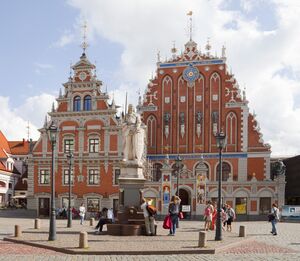
Riga began to develop as a centre of Viking trade during the early Middle Ages.[23] Riga's inhabitants occupied themselves mainly with fishing, animal husbandry, and trading, later developing crafts (in bone, wood, amber, and iron).[23]
The Livonian Chronicle of Henry testifies to Riga having long been a trading centre by the 12th century, referring to it as portus antiquus (ancient port), and describes dwellings and warehouses used to store mostly flax, and hides.[23] German traders began visiting Riga, establishing a nearby outpost in 1158.
Along with German traders the monk Meinhard of Segeberg[24] arrived to convert the Livonian pagans to Christianity. Catholic and Orthodox Christianity had already arrived in Latvia more than a century earlier, and many Latvians had been baptized.[23][24] Meinhard settled among the Livs, building a castle and church at Uexküll (now known as Ikšķile), upstream from Riga, and established his bishopric there.[24] The Livs, however, continued to practice paganism and Meinhard died in Uexküll in 1196, having failed in his mission.[25] In 1198, the Bishop Berthold arrived with a contingent of crusaders[25] and commenced a campaign of forced Christianization.[23][24] Berthold died soon afterwards and his forces were defeated.[25]
The Church mobilized to avenge this defeat. Pope Innocent III issued a bull declaring a crusade against the Livonians.[25] Bishop Albert was proclaimed Bishop of Livonia by his uncle Hartwig of Uthlede, Prince-Archbishop of Bremen and Hamburg in 1199. Albert landed in Riga in 1200[23][25] with 23 ships[26] and 500 Westphalian crusaders.[27] In 1201, he transferred the seat of the Livonian bishopric from Uexküll to Riga, extorting agreement to do this from the elders of Riga by force.[23]
Under Bishop Albert
وتأسست هذه المدينة عام 1201 ومع مرور العصور كانت ضحية عدم الاستقرار السياسي لبلاد البلطيق حيث احتلها على التوالي البولنديون(1561) والسويديون(1621) والروس(1710). وفي بداية القرن الثامن عشر عرفت ريغا بمرفئها المهم وبكونها مدينة تجارية كبرى ومن ثم في القرن التاسع عشر أصبحت تعرف أيضا بكونها مدينة صناعية. ونالت لاتفيا استقلالها في 18 نوفمبر عام 1918 غير أنه في بداية الحرب العالمية الثانية احتلها السوفييت قبل أن تصبح في يد النازيين أما في بداية الثمانينات فبدأت لاتفيا تخطو نحو الاستقلال الجديد في ظل وجود الرئيس ميخائيل گورباتشوف في الحكم في الاتحاد السوڤيتي حينها ونالت استقلالها فعليا في 21 أغسطس من عام 1991. وفي يناير من عام 1998 تم توقيع معاهدة التعاون الأمريكية-البلطيقية وكانت الولايات المتحدة تدعم انضمام دول البلطيق للمؤسسات الأوروبية ومن ضمنها منظمة حلف (الناتو). وكان لا بد للاتفيا من الانضمام الى (الناتو) والاتحاد الأوروبي للمحافظة على استقرارها الاقتصادي غير أن طريق الانضمام الى هاتين المنظومتين لم تكن سهلة اذ ان مباحثات الانضمام بدأت عام 1999 وطلب منها اجراء اصلاحات عدة كالغاء حكم الاعدام الى ان تم عام 2004 انضمام لاتفيا رسميا الى الاتحاد الأوروبي و(الناتو).[1]
. . . . . . . . . . . . . . . . . . . . . . . . . . . . . . . . . . . . . . . . . . . . . . . . . . . . . . . . . . . . . . . . . . . . . . . . . . . . . . . . . . . . . . . . . . . . . . . . . . . . . . . . . . . . . . . . . . . . . . . . . . . . . . . . . . . . . . . . . . . . . . . . . . . . . . . . . . . . . . . . . . . . . . . .
الجغرافيا
| المركز التاريخي لمدينة ريگا Historic Centre of Riga | |
|---|---|
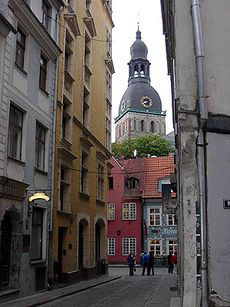 | |
| أسس الاختيار | Cultural: i, ii |
| المراجع | 852 |
| Inscription | 1997 (21st Session) |
وصنفت اليونسكو في عام 1997 وسط ريغا القديم ضمن التراث العالمي مما سمح وأوجب الحفاظ على معالم المدينة التاريخية كونها تمثل نوعا من الفن الفريد يشمل جميع الأساليب التاريخية من ناحية البناء وهو أمر يعود لتعدد البلدان والثقافات التي مرت في ريغا منذ عصور. والوسط القديم في ريغا مشهور بشوارعه وأزقته الضيقة وبيوته التاريخية المحافظة على معالمها حتى اليوم وفي وسط ريغا القديم يمكن رؤية أبراج وأجراس الكنائس التي تعود للقرون الوسطى. وتعرف ريغا أيضا بالفنادق الفاخرة وبمراكز التسوق وبالمطاعم والمقاهي الباهظة اضافة الى العديد من المنظمات الحكومية والمؤسسات الاقتصادية وكبرى الشركات الخاصة وأهم المصارف. ولا يزيد عدد سكان ريغا على 731 ألف نسمة ومساحتها على 307 كيلومترات مربعة وهي نسبة أقل بكثير مما كانت عليه في العام 1990 (912 ألف نسمة) وذلك بسبب رحيل نسبة كبيرة من السكان من أصل روسي عنها في حين أن عدد سكان لاتفيا التي تمتد على مساحة 64,500 كيلومتر مربع يصل الى 2.3 مليون نسمة.
Riga is the second largest city (after Vilnius) in the three Baltic states: Lithuania, Latvia, and Estonia.[28][29][30] Riga is home to approximately one tenth of the three Baltic countries' combined population.[31]
Administrative divisions
- Central District (3 km2 or 1.2 sq mi)
- Kurzeme District (79 km2 or 31 sq mi)
- Zemgale Suburb (41 km2 or 16 sq mi)
- Northern District (77 km2 or 30 sq mi)
- Vidzeme Suburb (57 km2 or 22 sq mi)
- Latgale Suburb (50 km2 or 19 sq mi)
Riga's administrative divisions consist of six administrative entities: Central, Kurzeme and Northern districts and the Latgale, Vidzeme and Zemgale suburbs. Three entities were established on 1 September 1941, and the other three were established in October 1969.[32] There are no official lower-level administrative units, but the Riga City Council Development Agency is working on a plan, which officially makes Riga consist of 58 neighbourhoods.[33] The current names were confirmed on 28 December 1990.[34]
Climate
The climate of Riga is humid continental (Köppen Dfb).[35] The coldest months are January and February, when the average temperature is −2.1 °C (28 °F) but temperatures as low as −20 to −25 °C (−4 to −13 °F) can be observed almost every year on the coldest days. The proximity of the sea causes frequent autumn rains and fogs. Continuous snow cover may last eighty days. The summers in Riga are mild and rainy with an average temperature of 18 °C (64 °F), while the temperature on the hottest days can exceed 30 °C (86 °F).
| بيانات مناخ Riga (1991−2020 normals, extremes 1885-present) | |||||||||||||
|---|---|---|---|---|---|---|---|---|---|---|---|---|---|
| الشهر | يناير | فبراير | مارس | أبريل | مايو | يونيو | يوليو | أغسطس | سبتمبر | اكتوبر | نوفمبر | ديسمبر | العام |
| العظمى القياسية °س (°ف) | 10.2 (50.4) |
13.6 (56.5) |
20.5 (68.9) |
27.9 (82.2) |
30.5 (86.9) |
34.0 (93.2) |
34.5 (94.1) |
33.9 (93) |
29.4 (84.9) |
23.4 (74.1) |
17.2 (63) |
11.8 (53.2) |
34٫5 (94٫1) |
| العظمى المتوسطة °س (°ف) | -0.1 (31.8) |
0.3 (32.5) |
4.8 (40.6) |
11.9 (53.4) |
17.8 (64) |
21.3 (70.3) |
23.8 (74.8) |
22.7 (72.9) |
17.3 (63.1) |
10.5 (50.9) |
4.8 (40.6) |
1.4 (34.5) |
11٫38 (52٫48) |
| المتوسط اليومي °س (°ف) | -2.1 (28.2) |
-2.0 (28.4) |
1.5 (34.7) |
7.4 (45.3) |
13.0 (55.4) |
16.7 (62.1) |
19.3 (66.7) |
18.3 (64.9) |
13.4 (56.1) |
7.5 (45.5) |
3.0 (37.4) |
-0.3 (31.5) |
7٫98 (46٫36) |
| الصغرى المتوسطة °س (°ف) | -4.5 (23.9) |
-4.6 (23.7) |
-1.7 (28.9) |
2.9 (37.2) |
8.2 (46.8) |
12.4 (54.3) |
14.9 (58.8) |
14.1 (57.4) |
9.8 (49.6) |
4.9 (40.8) |
1.1 (34) |
-2.4 (27.7) |
4٫59 (40٫27) |
| الصغرى القياسية °س (°ف) | −33.7 (-28.7) |
−34.9 (-30.8) |
−30.3 (-22.5) |
−13.1 (8.4) |
−5.5 (22.1) |
−2.3 (27.9) |
4.0 (39.2) |
0.0 (32) |
−4.1 (24.6) |
−9.5 (14.9) |
−20.5 (-4.9) |
−31.9 (-25.4) |
−34٫9 (−30٫8) |
| هطول mm (inches) | 46.5 (1.831) |
40.1 (1.579) |
34.1 (1.343) |
35.0 (1.378) |
47.5 (1.87) |
65.0 (2.559) |
79.5 (3.13) |
77.9 (3.067) |
67.1 (2.642) |
75.6 (2.976) |
56.3 (2.217) |
50.2 (1.976) |
674٫8 (26٫567) |
| سقوط الثلج cm (inches) | 25.0 (9.84) |
23.6 (9.29) |
15.7 (6.18) |
5.2 (2.05) |
0.0 (0) |
0.0 (0) |
0.0 (0) |
0.0 (0) |
0.0 (0) |
1.2 (0.47) |
7.0 (2.76) |
22.0 (8.66) |
99٫7 (39٫25) |
| % Humidity | 87.9 | 85.2 | 79.4 | 69.7 | 67.7 | 72.0 | 74.2 | 76.7 | 81.1 | 85.1 | 90.2 | 89.4 | 79٫9 |
| Avg. precipitation days (≥ 1.0mm) | 9.4 | 7.0 | 8.2 | 8.0 | 7.7 | 8.9 | 11.2 | 10.9 | 12.3 | 11.6 | 12.5 | 12.2 | 119٫9 |
| Sunshine hours | 36.6 | 64.2 | 141.2 | 203.6 | 286.7 | 282.2 | 291.2 | 250.4 | 166.7 | 95.5 | 36.1 | 24.4 | 1٬878٫8 |
| Source #1: Latvian Environment, Geology and Meteorology Agency (temperature, precipitation and sunshine)[36][37] | |||||||||||||
| Source #2: NOAA (precipitation days 1961-1990),[38] Weather Atlas,[39] and World Weather Online (snowfall)[40] | |||||||||||||
| Coastal temperature data for Riga (Daugavgrīva) | |||||||||||||
|---|---|---|---|---|---|---|---|---|---|---|---|---|---|
| Month | Jan | Feb | Mar | Apr | May | Jun | Jul | Aug | Sep | Oct | Nov | Dec | Year |
| Average sea temperature °C (°F) | 1.0 (33.80) |
0.7 (33.26) |
0.5 (32.90) |
3.0 (37.40) |
9.1 (48.38) |
15.5 (59.90) |
19.6 (67.28) |
19.4 (66.92) |
16.3 (61.34) |
11.3 (52.34) |
7.4 (45.32) |
4.3 (39.74) |
9.0 (48.21) |
| Source 1: Seatemperature.org[41] | |||||||||||||
. . . . . . . . . . . . . . . . . . . . . . . . . . . . . . . . . . . . . . . . . . . . . . . . . . . . . . . . . . . . . . . . . . . . . . . . . . . . . . . . . . . . . . . . . . . . . . . . . . . . . . . . . . . . . . . . . . . . . . . . . . . . . . . . . . . . . . . . . . . . . . . . . . . . . . . . . . . . . . . . . . . . . . . .
Government
The head of the city government in Riga is the mayor, or officially the Chairman of the Riga City Council. He is assisted by one or more Vice Mayors (deputy mayors). The current mayor since October 2020 is Mārtiņš Staķis elected from Movement For!, which is a part of the Development/For!/Progressives faction, but on 24 March 2022, he left the party. The three other parties in the governing coalition each received a Vice Mayor post.
The city council is a democratically elected institution and is the final decision-making authority in the city. The Council consists of 60 members or deputies who are elected every four years. The Presidium of the Riga City Council consists of the Chairman of the Riga City Council and the representatives delegated by the political parties or party blocks elected to the City Council. From February to October 2020, the offices of the Mayor and Vice Mayors were suspended and the council itself had been dissolved and replaced by an interim administration of representatives from three governmental ministries until snap elections were held in 2020.
Demographics
With 605,800 inhabitants in 2022 as according to the Central Statistical Bureau of Latvia, Riga was the largest city in the Baltic states, though its population has decreased from just over 900,000 in 1991[9] and the population of Vilnius has just outnumbered that of Riga. Notable causes include emigration and low birth rates. According to the 2022 data, ethnic Latvians made up 47.4% of the population of Riga. Russians formed 35.7%, Belarusians 3.6%, Ukrainians 3.5%, Poles 1.7%, other ethnicities consisted 8.2%. By comparison, 63.0% of Latvia's total population was ethnically Latvian, 24.2% Russian, 3.1% Belarusian, 2.2% Ukrainian, 1.9% Polish, 1.1% are Lithuanian and the rest of other origins.
Upon the restoration of Latvia's independence in 1991, Soviet-era immigrants (and any of their offspring born before 1991) were not automatically granted Latvian citizenship because they had migrated to the territory of Latvia during the years when Latvia was part of the Soviet Union. The proportion of ethnic Latvians in Riga increased from 36.5% in 1989 to 47.4% in 2022. In contrast, the percentage of Russians fell from 47.3% to 35.7% in the same time period. In 2022 citizens of Latvia made up 79.0%, non-citizens 15.3% and citizens of other countries 5.6% of the population of Riga.
Historic population figures
| التعداد التاريخي | ||||||||||||||||||||||||||||||||||||||||||||||||||||||||||||||
|---|---|---|---|---|---|---|---|---|---|---|---|---|---|---|---|---|---|---|---|---|---|---|---|---|---|---|---|---|---|---|---|---|---|---|---|---|---|---|---|---|---|---|---|---|---|---|---|---|---|---|---|---|---|---|---|---|---|---|---|---|---|---|
|
|
| ||||||||||||||||||||||||||||||||||||||||||||||||||||||||||||
Economy
Riga is one of the key economic and financial centres of the Baltic states. Roughly half of all the jobs in Latvia are in Riga and the city generates more than 50% of Latvia's GDP as well as around half of Latvia's exports. The biggest exporters are in wood products, IT, food and beverage manufacturing, pharmaceuticals, transport and metallurgy.[42] Riga Port is one of the largest in the Baltics. It handled a record 34 million tons of cargo in 2011[43] and has potential for future growth with new port developments on Krievu Sala.[44] Tourism is also a large industry in Riga and after a slowdown during the global economic recessions of the late 2000s, grew 22% in 2011 alone.[45]
Riga was intended to become the global financial centre in the former Soviet Union. One bank, which provided high levels of secrecy for its customers, promoted itself as "We are closer than Switzerland!" (روسية: «Мы ближе, чем Швейцария!»).[46][47][48][أ] On 28 July 1995, twenty Latvian banks with assistance of persons from the Paris Stock Exchange organised the Riga Stock Exchange which was the first Latvian stock exchange in Riga.[50]
Culture
Theatres
- The Latvian National Opera was founded in 1918. The repertoire of the theatre embraces all opera masterpieces. The Latvian National Opera is famous not only for its operas, but for its ballet troupe as well.[51]
- The Latvian National Theatre was founded in 1919. The Latvian National Theatre preserves the traditions of Latvian drama school. It is one of the biggest theatres in Latvia.[52]
- The Mikhail Chekhov Riga Russian Theatre is the oldest professional drama theatre in Latvia, established in 1883. The repertoire of the theatre includes classical plays and experimental performances of Russian and other foreign playwrights.
- The Daile Theatre was opened for the first time in 1920. It is one of the most successful theatres in Latvia and is distinguished by its frequent productions of modern foreign plays.[53]
- Latvian State Puppet Theatre was founded in 1944 and presents shows for children and adults.[54]
- The New Riga Theatre was opened in 1992.
World Choir Games
Riga hosted the biannual 2014 World Choir Games from 9 to 19 July 2014 which coincided with the city being named European Capital of Culture for 2014.[55][56] The event, organised by the choral foundation, Interkultur, takes place at various host cities every two years and was originally known as the "Choir Olympics".[57] The event regularly sees over 15,000 choristers in over 300 choirs from over 60 nations compete for gold, silver and bronze medals in over 20 categories. The competition is further divided into a Champions Competition and an Open Competition to allow choirs from all backgrounds to enter.[55] Choral workshops and festivals are also witnessed in the host cities and are usually open to the public.[58]
Architecture
The radio and TV tower of Riga is the tallest structure in Latvia and the Baltic States, and one of the tallest in the European Union, reaching 368.5 m (1,209 ft). Riga centre also has many great examples of Gothic revival architecture, such as the Kalpaka Boulevard Library, and a bevy of Art Nouveau architecture, as well as a medieval old town.[59]
Art Nouveau
Riga has one of the largest collections of Art Nouveau buildings in the world, with at least 800 buildings.[59] This is due to the fact that at the end of the 19th and beginning of the 20th centuries, when Art Nouveau was at the height of its popularity, Riga experienced an unprecedented financial and demographic boom.[60] In the period from 1857 its population grew from 282,000 (256,200 in Riga itself and another 26,200 inhabitants beyond the city limits in the patrimonial district and military town of Ust-Dvinsk) to 472,100 in 1913.[61][62] The middle class of Riga used their acquired wealth to build imposing apartment blocks outside the former city walls. Local architects, mostly graduates of Riga Technical University, adopted current European movements and in particular Art Nouveau.[63] Between 1910 and 1913, between 300 and 500 new buildings were built each year in Riga, many of them in Art Nouveau style and most of them outside the old town.[63]
Alberta iela 13
Sports
Riga has a rich basketball history. In the 1950s, Rīgas ASK became the best club in the Soviet Union and also in Europe, winning the first three editions of the European Cup for Men's Champions Clubs from 1958 to 1960.[64]
In 1960, ASK was not the only team from Riga to take the European crown. TTT Riga clinched their first title in the European Cup for Women's Champion Clubs, turning Riga into the capital city of European basketball because for the first and, to date, only time in the history of European basketball, clubs from the same city were concurrent European men's and women's club champions.[65]
In 2015, Riga was one of the hosts for EuroBasket 2015.
Sports clubs
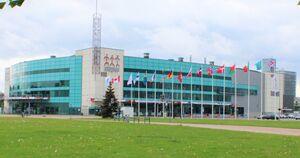
- Basketball
- BK VEF Rīga – a professional basketball team that is a three-time Latvian champion. VEF also participates in high-level international competition such as Eurocup
- Barons LMT – a men's basketball team, two-time Latvian champion, as well as the 2008 FIBA EuroCup winner
- TTT Riga – a women's basketball team, which between 1960 and 1982 won eighteen FIBA EuroLeague Women titles
- Ice hockey
- Dinamo Riga – a professional ice hockey club established in 2008. It played in the Kontinental Hockey League until 2022. Dinamo was established as a successor to the former hockey team with the same name, which was founded in 1946 but ceased to exist in 1995.
- HK Riga – a junior hockey club, playing in the Minor Hockey League
- Football
- Riga FC – Riga Football Club, commonly referred to as Riga FC, were established in 2015 after a merger of two Riga based teams – FC Caramba Riga and Dinamo Rīga. In 2018 they became champions of the Virslīga Latvian Higher League for the first time.
- RFS – FK Rīgas Futbola Skola, known as RFS are based on the Riga Football School (RFS) academy, established in 1962.
- FS Metta-LU – founded in 2006. Metta play their home games at Daugava Stadium.
- JDFS Alberts – Jura Docenko Futbola Skola Alberts, commonly referred to as JDFS Alberts was founded as a football school in 2008 and subsequently became a professional Latvian football league team.
- Riga United FC[66]
- FC New Project
- Dissolved Football Clubs
- Skonto FC – Skonto FC was a football club established in 1991. The club won fourteen successive Latvian Higher League titles. For a long time it provided the core of the Latvian national football team. Following financial problems, the club was demoted to the Latvian First League in 2016 and went bankrupt in December of that year and subsequently dissolved.
- JFK Olimps – JFK Olimps played in the top division of Latvian football. The club was founded in 2005 and dissolved in 2012. According to a study from January 2011, the club was the youngest team in Europe, with an average age of 19.02 years.
Sports facilities
- Arena Riga – a multi-purpose arena built in 2006 as the main venue for the 2006 Men's World Ice Hockey Championships. It can hold up to 14,500 people and has hosted ice hockey, basketball and volleyball events, as well as Red Bull X-Fighters
- Skonto Stadium – a football stadium, built in 2000. It is the main stadium used for games of the Latvian national football team and the home stadium of Riga FC. The stadium was previously the home stadium of Skonto FC prior to the team's dissolution.
- Daugava Stadium – a stadium built in 1958, used for both football and athletics
- Latvijas Universitates Stadions
- Biķernieki Complex Sports Base – Latvia's leading motorsport complex
Sports events
- EuroBasket 1937
- 1999 European Athletics Junior Championships
- EuroBasket Women 2009
- 2006 Men's World Ice Hockey Championships
- Riga Marathon
- 2013 World Women's Curling Championship
- 2014 Cricket Latvia play Masstor Cricket Club
- EuroBasket 2015
- 2016 Men's World Floorball Championships[67]
- 2021 IIHF World Championship
- FIDE Grand Swiss Tournament 2021
Transport
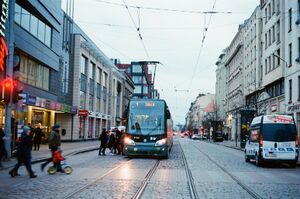
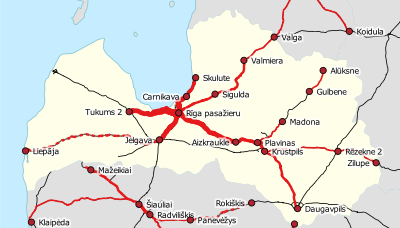
Riga, with its central geographic position and concentration of population, has always been the infrastructural hub of Latvia. Several national roads begin in Riga, and European route E22 crosses Riga from the east and west, while the Via Baltica crosses Riga from the south and north.
As a city situated by a river, Riga also has several bridges. The oldest-standing bridge is the Railway Bridge, which is also the only railroad-carrying bridge in Riga. The Stone Bridge (Akmens tilts) connects Old Riga and Pārdaugava; the Island Bridge (Salu tilts) connects Maskavas Forštate and Pārdaugava via Zaķusala; and the Shroud Bridge (Vanšu tilts) connects Old Riga and Pārdaugava via Ķīpsala. In 2008, the first stage of the new Southern Bridge (Dienvidu tilts) route across the Daugava was completed, and was opened to traffic on 17 November.[68]
The Southern Bridge was the biggest construction project in the Baltic states in 20 years, and its purpose was to reduce traffic congestion in the city centre.[69][70] Another major construction project is the planned Riga Northern transport corridor;[71] its first segment detailed project was completed in 2015.[72]
The Freeport of Riga facilitates cargo and passenger traffic by sea. Sea ferries connect Riga Passenger Terminal to Stockholm operated by Tallink.[73] Riga has one active airport that serves commercial airlines—the Riga International Airport (RIX), built in 1973. It is the primary hub of AirBaltic and a base for RyanAir.[74] Renovation and modernisation of the airport was completed in 2001, coinciding with the 800th anniversary of the city. In 2006, a new terminal extension was opened. Extension of the runway was completed in October 2008, and the airport is now able to accommodate large aircraft such as the Airbus A340, Boeing 747, 757, 767 and 777. Another terminal extension is under construction اعتبارا من 2014[تحديث].[75] The annual number of passengers has grown from 310,000 in 1993 to 4.7 million in 2014, making Riga International Airport the largest in the Baltic States. A new multi-modal hub is planned around the airport with a Rail Baltica station and airport city development planned.[76][77]
The former international airport of Riga, Spilve Airport, located 5 km (3 mi) from Riga city centre, is used for small aircraft, pilot training and recreational aviation. Riga was also home to a military air base during the Cold War—Rumbula Air Base.
Public transport in the city is provided by Rīgas Satiksme which operates a large number of trams, buses and trolleybuses on an extensive network of routes across the city. In addition, up until 2012 many private owners operated minibus services, after which the City Council established the unified transport company Rīgas mikroautobusu satiksme, establishing a monopoly over the service.
Riga International Coach Terminal provides domestic and international connections by coach.
As the population of Riga city started to approach 1 million people in the 1980s, the city became eligible (under the Soviet standards of the time) for the construction of a subway system Riga Metro, which would have been paid for by the Soviet government. However, the population decline and shortage of funding following Latvian independence put an end to this plan.
Riga is connected to the rest of Latvia by domestic trains operated by the national carrier Passenger Train, whose headquarters are in Riga. The main railway station is the Riga Central Station. It has stops for public transport along the streets Satekles iela, 13. janvāra iela Marijas iela, and Merķeļa iela. There are also international rail services to Russia and Belarus, and plans to revive passenger rail traffic with Estonia. International overnight service is with Latvia Express trains (باللاتڤية: [Latvijas Ekspresis] Error: {{Lang}}: text has italic markup (help)). A TEN-T project called Rail Baltica envisages building a high-speed railway line via Riga connecting Tallinn to Warsaw using standard gauge,[78] expected to be put into operation in 2024.[79] Latvian Railways (باللاتڤية: [Latvijas dzelzceļš] Error: {{Lang}}: text has italic markup (help) or LDz) operates the Latvian Rail History Museum in Riga.
Universities
- University of Latvia (LU)
- Art Academy of Latvia (LMA)
- Riga Technical University (RTU)
- Riga Stradiņš University (RSU)
- Riga Graduate School of Law (RGSL)
- Stockholm School of Economics in Riga (SSE Riga)
- BA School of Business and Finance (BA)
- Transport and Telecommunication Institute (TTI)
- Riga International School of Economics and Business Administration (RISEBA)
- Turība University
- Riga Aeronautical Institute (RAI)
Notable people
Public service

- Sir Isaiah Berlin (1909–1997), a British social and political theorist, philosopher and historian of ideas
- Emil Friedrich von Boetticher (1836–1907) a politician, burgomaster of Riga
- Friedrich Heinrich von Boetticher (1826–1902) a German publisher, bookseller, scholar and art historian.
- Deniss Čalovskis (born 1985), Latvian computer hacker who created the Gozi virus.
- Valdis Dombrovskis (born 1971), a Latvian politician and EU Commissioner
- Laila Freivalds (born 1942), former Swedish Minister for Justice and Deputy Prime Minister of Sweden
- Juris Hartmanis (1928–2022), a Latvian-American computer scientist, won the 1993 Turing Award
- Nicolai Hartmann (1882–1950), a Baltic German philosopher, an important metaphysician
- Johann Gottfried Herder (1744–1803), a German philosopher, theologian, poet and literary critic
- Albert Woldemar Hollander (1796–1868), a German educator and pedagog.
- Yeshayahu Leibowitz (1903–1994), an Israeli public intellectual and polymath
- Yosef Mendelevich (born 1947), a Jewish refusenik from the Soviet Union, known as a "Prisoner of Zion"
- Ernst Munzinger (1887–1945), German Abwehr (Army intelligence) officer, later anti-Nazi
- Valters Nollendorfs (born 1931), chairman of the board of the Museum of the Occupation of Latvia
- Alfred Rosenberg (1892–1946), a Baltic German theorist and ideologue of the Nazi Party
- Johann Steinhauer (1705–1779) a Latvian entrepreneur, social reformer and landowner
- Charlotte Wahl (1817–1899), a Latvian-born philanthropist
- Tatiana Warsher (1880–1960), a Russian archaeologist known for her studies of Pompeii
The Arts


- Rutanya Alda (born 1942), a Latvian-American actress
- Mikhail Baryshnikov (born 1948), a Russian dancer, choreographer and actor
- Léopold Bernhard Bernstamm (1859–1939), a Russian sculptor
- Gunnar Birkerts (1925–2017), a Latvian-American architect
- Leonīds Breikšs (1908–1942), a Latvian poet, author and newspaper editor
- Jacob W. Davis (born Jākobs Jufess, 1831–1908), an American tailor, invented modern jeans.
- Mikhail Eisenstein (1867–1920), a Latvian civil engineer and architect
- Vera Mukhina (1889–1953), a Soviet sculptor and painter
- Sergei Eisenstein (1898–1948), a Soviet Russian film director, filmed Battleship Potemkin
- Heinz Erhardt (1909–1979), a Baltic German comedian, musician and entertainer
- Artur Fonvizin (1883–1973), a Soviet painter of watercolours
- Michael Polakovs (1923–2009), an American circus clown and actor
- Mārtiņš Brauns (1951–2021), a Latvian composer and musician
- Elīna Garanča (born 1976), a Latvian operatic mezzo-soprano
- Philippe Halsman (1906–1979), an American portrait photographer
- Aivars Kalējs (born 1951), a Latvian composer, organist and pianist
- Gidon Kremer (born 1947), a Latvian classical violinist and conductor
- Barbara von Krüdener (1764–1824), a Baltic German author, religious mystic and Pietist Lutheran theologian.[80]
- Ivan Krylov (1769–1844), a Russian fable writer
- DJ Lethal (born Leor Dimant in 1972), an American music producer
- Alan Melikdjanian (born 1980), a Latvian-American independent filmmaker known as Captain Disillusion
- Raimonds Pauls (born 1936), a Latvian composer and piano player
- Kristjan Jaak Peterson (1801–1822), an Estonian poet
- Valentin Pikul (1928–1990), a Soviet historical novelist
- Marie Seebach (1829–1897), a German actress.[81]
- Ksenia Solo (born 1987), a Latvian-Canadian actress and activist
Science
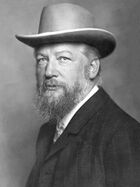
- Ernst von Bergmann (1836–1907), a Baltic German surgeon, pioneer of aseptic surgery
- Walter von Boetticher (1853–1945) a German historian, genealogist and physician.
- Jakob Benjamin Fischer (1731–1793), a Baltic German naturalist and apothecary
- Lola Hoffmann (1904–1988), a physiologist, psychiatrist and guide to self-development and transformation
- Charles Kalme (1939–2002), an American mathematician and International Master of chess
- Karlis Kaufmanis (1910–2003), astronomer, he lectured that the Star of Bethlehem was a conjunction in 7 BC of the planets Jupiter and Saturn
- Mstislav Keldysh (1911–1978), a Soviet mathematician, worked on the first artificial satellite
- George Nagobads (1921–2023), American physician, recipient of the Paul Loicq Award.[82]
- Wilhelm Ostwald (1853–1932), a Baltic German chemist, Nobel Prize in Chemistry in 1909
- Georg August Schweinfurth (1836–1925) a Baltic German botanist and ethnologist who explored East Central Africa.[83]
- Georg von Tiesenhausen (1914–2018), a Baltic German American rocket scientist.
- Juris Upatnieks (born 1936), a Latvian-American physicist and inventor, pioneer in the field of holography.
- Friedrich Zander (1887–1933), a Baltic German engineer, designed the first Soviet liquid-fuelled rocket
- Walter Zapp (1905–2003), a Baltic German inventor, he created the Minox subminiature camera.


Sport
- Helmuts Balderis (born 1952) a Latvian former ice hockey player
- Dāvis Bertāns (born 1992), professional basketball player
- Jānis Beinarovičs (1907–1967), wrestler
- Andris Biedriņš (born 1986), former basketball player
- Sergejs Boldaveško (born 1970), retired ice hockey player, born in Riga
- Teddy Blueger (born 1994), ice hockey player for the Pittsburgh Penguins
- Tanhum Cohen-Mintz (1939–2014), Israeli basketball player
- Elīna Dikaioulaku (born 1989), basketball player for Israeli team Elitzur Ramla
- Kaspars Dubra (born 1990), footballer with 50 caps for Latvia
- Zemgus Girgensons (born 1994), ice hockey player, highest-ever drafted Latvian in the NHL Entry Draft
- Jørgen Hviid (1916–2001), Danish and Latvian athlete; ice hockey, speed skating and sailing.
- Miervaldis Jurševskis (1921–2014), Latvian-Canadian chess master and a professional artist.
- Matīss Kivlenieks (1996–2021), ice hockey goaltender for the Columbus Blue Jackets
- Rūdolfs Kundrāts (1907–1954), footballer and referee with 19 caps for Latvia.
- Elvis Merzļikins (born 1994), ice hockey goaltender for the Columbus Blue Jackets
- Anete Muižniece-Brice (born 1962), former basketball player
- Jeļena Ostapenko (born 1997), women's tennis player, 2017 French Open – Women's singles winner
- Sandis Ozoliņš (born 1972), ice hockey player, a seven-time NHL All-Star, Stanley Cup champion
- Marians Pahars (born 1976), footballer with 75 caps for Latvia
- Harald Schlegelmilch (born 1987), racing driver
- Alexei Shirov (born 1972), Latvian / Spanish chess grandmaster, ranked world No. 2 in 1994
- Karlīne Štāla (born 1986), racing driver
- Mikhail Tal (1936–1992), Soviet-Latvian chess grandmaster, 8th World Chess Champion
- Valdis Valters (born 1957) retired basketball player
Twin towns – sister cities
 Aalborg, Denmark
Aalborg, Denmark Almaty, Kazakhstan
Almaty, Kazakhstan Astana, Kazakhstan
Astana, Kazakhstan Beijing, China
Beijing, China Bordeaux, France
Bordeaux, France Bremen, Germany
Bremen, Germany Cairns, Australia
Cairns, Australia Dallas, United States
Dallas, United States Florence, Italy
Florence, Italy Kaunas, Lithuania[85]
Kaunas, Lithuania[85] Kyiv, Ukraine
Kyiv, Ukraine Kobe, Japan
Kobe, Japan Norrköping, Sweden
Norrköping, Sweden Pori, Finland
Pori, Finland Rostock, Germany
Rostock, Germany Santiago, Chile
Santiago, Chile Stockholm, Sweden
Stockholm, Sweden Suzhou, China
Suzhou, China Taipei, Taiwan
Taipei, Taiwan- قالب:Country data GB Slough, England
 Tallinn, Estonia
Tallinn, Estonia Tartu, Estonia
Tartu, Estonia Tashkent, Uzbekistan
Tashkent, Uzbekistan Tbilisi, Georgia
Tbilisi, Georgia Vilnius, Lithuania
Vilnius, Lithuania Warsaw, Poland
Warsaw, Poland Yerevan, Armenia
Yerevan, Armenia
النقل
السكك الحديدية و الطرق البرية تتركز حول العاصمة ريغا. تستعمل السكك أكثرها لأغراض نقل البضائع، و لكن هناك خطوط لنقل الركاب تربط البلاد بالمدن القريبة المهمة كفيلينيوس، كاوناس، مينسك، موسكو و سانت بطرسبورغ. مطار ريغا هو أكبر مطار بالبلاد، الذي تتخذ منه شركة البلطيق الدولية للطيران مقراً لها. يخترق الطريق السريع طريق البلطيق من جنوب البلاد الى شمالها. هناك موانئ بحرية في ريغا، فينتسبيلس و ليبايا، كما تُسير منهم عدة عبّارات الى الدول الاسكندنافية و المانيا.
المدن الشقيقة
Riga maintains sister city relationships with the following cities:[86]
السياحة
تعتبر العاصمة ريغا من اهم مدن البلطيق و هي تتميز بهندستها المعمارية العالمية مع الاحتفاظ ببعض اللمسات التقليدية المحلية اما المدينة القديمة فقد استطاعت المحافظة على طابع المدن القرطوسية المحصنة و ينصحالسياح القيام بنزهة سيرا على الاقدام لاكتشاف اسرارها . و ريغا احدى المدن الاكثر اخضرارا في المنطقة و يطلق عليها القاب عدة لعل ابرزها "مدينة الالهام" و "باريس الشمال"و هي تجمع المراكز الدينية و الثقافية و الهندسية للبلاد اضافة الى مجموعات من الابنية المشيدة وفق الطراز الاوربي الحديث او الطراز الروماني . او القوطي او الكلاسيكي اما الاثار الموجودة في ريغا و التى لايمكن ان تفوت فتتمثل في كاتدرائية "سان بيار"قصر "ريغا" منزل الاخوة الثلاثة برج مخزن البارود مصنع الاسلحة السويدية القديم و الاوبرا الوطنية تمثال الحرية .
وتقع الآثار على مسافات متقاربة جدا بحيث يمكنكم مشاهدتها في وقت قصير و تقدم لكم ريغا ايضا استراحات و اماكن للهو ترضي جميع الاذواق و تناسب الفئات العمرية كافة و كذلك اماكن السهر و صالات السينما و المسارح التقليدية و المعارض بدو ان ننسى حديقة الحيوانات و المتحف في الهواء الطلق الذى يعتبر مكانا مثاليا للقيام بنزهة . و تعج ريغا بعدد كبير من المطاعم الفرنسية و الايطالية و الايرلندية و البريطانية و التى تتجاور مع المطاعم التى تقدم لوائح طعام لتوانية و التى اصبحت تشكل احد العوامل الاساسية الجاذبة للسياح و هذا العدد الهائل من المطاعم هو في تزايد مستمر
المصادر
انظر ايضا
ملاحظات
- ^ Richard L. Palmer, president of Cachet International, Inc., was the CIA station chief at the United States Embassy in Moscow from 1992 to 1994.[48][49]
المصادر
- ^ "Vilnis Ķirsis becomes Mayor of Rīga". www.eng.lsm.lv. Retrieved 18 أغسطس 2023.
- ^ "Riga City Council". Riga City Council. Archived from the original on 25 ديسمبر 2018. Retrieved 22 يوليو 2009.
- ^ "Population on 1 January by age groups and sex – functional urban areas". Eurostat. Archived from the original on 3 سبتمبر 2015. Retrieved 26 يوليو 2021.
- ^ "METRO – "The role and future perspectives of Cohesion Policy in the planning of Metropolitan Areas and Cities"". ESPON. 27 أكتوبر 2020. p. 1. Archived from the original on 14 مايو 2021. Retrieved 26 يوليو 2021.
- ^ "Gross domestic product by region and city (at current prices) 2000 - 2020". stat.gov.lv. Archived from the original on 30 ديسمبر 2022. Retrieved 30 ديسمبر 2022.
- ^ "Riga City Council expects EUR 140 million more in budget revenue than last year". Archived from the original on 15 أبريل 2023. Retrieved 15 أبريل 2023.
- ^ "Sub-national HDI – Subnational HDI – Global Data Lab". globaldatalab.org. Archived from the original on 15 أبريل 2023. Retrieved 15 أبريل 2023.
- ^ "Historic Centre of Riga". UNESCO World Heritage Centre. UNESCO. Archived from the original on 22 يونيو 2020. Retrieved 13 مايو 2022.
- ^ أ ب "Population by sex in regions, cities, municipalities, towns and rural territories at the beginning of year". Central Statistical Bureau, official statistics of Latvia. Retrieved 3 أكتوبر 2022.
- ^ أ ب "Riga Municipality Portal". Copyright 2003–2009, www.riga.lv/LV/Channels/ Riga Municipality. Archived from the original on 28 أغسطس 2011. Retrieved 27 يوليو 2009.
- ^ "Historic Centre of Riga – UNESCO World Heritage Centre". UNESCO. 1997. Archived from the original on 22 يونيو 2020. Retrieved 18 ديسمبر 2012.
- ^ "Tourist numbers in Riga expected to reach 80% of pre-pandemic figure this year - LiveRiga". baltictimes.com. Retrieved 13 مايو 2023.
- ^ "EUROCITIES – the network of major European cities". Eurocities. Archived from the original on 24 أغسطس 2020. Retrieved 8 نوفمبر 2011.
- ^ "Union of the Baltic Cities". Union of the Baltic Cities (UBC). Archived from the original on 15 أكتوبر 2007. Retrieved 8 نوفمبر 2011.
- ^ "Union of Capitals of the European Union". Union of Capitals of the European Union (UCEU). Archived from the original on 20 أكتوبر 2011. Retrieved 8 نوفمبر 2011.
- ^ "Teritorija un administratīvās robežas vēsturiskā skatījumā" (in اللاتفية). Cities Environmental Reports on the Internet. Archived from the original on 13 أغسطس 2007. Retrieved 2 أغسطس 2007.
- ^ "Endzelīns, Did Celts Inhabit the Baltics (1911 Dzimtene's Vēstnesis (Homeland Messenger) No. 227)". Archived from the original on 9 ديسمبر 2008. Retrieved 24 يوليو 2009.
- ^ "Riga municipality portal". www.riga.lv. Archived from the original on 23 فبراير 2012. Retrieved 10 فبراير 2016.
- ^ "Coat of arms of Riga". www.riga.lv. Archived from the original on 11 يوليو 2007. Retrieved 26 يونيو 2018.
- ^ Vauchez et al. Encyclopedia of the Middle Ages. Routledge, 2001
- ^ Fabrius, D. Livonicae Historiae Compendiosa Series, 1610
- ^ Bilmanis, A. Latvia as an Independent State. Latvian Legation. 1947.
- ^ أ ب ت ث ج ح خ د ذ Bilmanis, A. Latvia as an Independent State. Latvian Legation. 1947.
- ^ أ ب ت ث Vauchez et al. Encyclopedia of the Middle Ages. Routledge, 2001
- ^ أ ب ت ث ج Germanis, U. The Latvian Saga. 10th ed. 1998. Memento, Stockholm.
- ^ Laffort, R. (censor), Catholic Encyclopedia, Robert Appleton Co., 1907
- ^ Tolstoy-Miloslavsky, D. The Tolstoys: Genealogy and Origin. A2Z, 1991
- ^ "Statistics of Vilnius; municipality of Vilnius". Archived from the original on 30 سبتمبر 2022. Retrieved 3 أكتوبر 2022.
- ^ "It happened: Vilnius became the largest city in the Baltic States". Archived from the original on 3 أكتوبر 2022. Retrieved 3 أكتوبر 2022.
- ^ "It happened: Vilnius became the largest city in the Baltic States". Archived from the original on 4 أكتوبر 2022. Retrieved 4 أكتوبر 2022.
- ^ "Latvia in Brief". Latvian Institute. 2011. Archived from the original on 26 ديسمبر 2018. Retrieved 5 نوفمبر 2011.
- ^ Mikk Lõhmus & Illar Tõnisson. "Evolvement of Administrative Division of Tallinn, Riga and Vilnius" (PDF). Tallinn University of Technology. pp. 55, 77. Archived (PDF) from the original on 20 يوليو 2011. Retrieved 29 يونيو 2010.
- ^ "Apkaimju projekts" (in اللاتفية). Riga City Council Development Agency. Archived from the original on 25 مايو 2010. Retrieved 29 يونيو 2010.
- ^ "Changes in the Administrative Division of the Territory of Riga after the Loss of Independence (1940–1991)". Riga City Environment Centre "Agenda 21". Archived from the original on 23 يوليو 2011. Retrieved 29 يونيو 2010.
- ^ "Hypothesis for modelling: Meteorological data" (PDF). European Union. 2015. Archived from the original (PDF) on 24 مارس 2020. Retrieved 24 مارس 2020.
- ^ "Klimatisko normu dati" (in اللاتفية). Latvian Environment, Geology and Meteorology Centre. Archived from the original on 13 يناير 2023. Retrieved 17 مارس 2023.
- ^ "Gaisa temperatūras rekordi" (in اللاتفية). Latvian Environment, Geology and Meteorology Centre. Archived from the original on 13 يناير 2023. Retrieved 17 مارس 2023.
- ^ "Riga Climate Normals 1961–1990". National Oceanic and Atmospheric Administration. Archived from the original on 31 مارس 2023. Retrieved 2 فبراير 2013.
- ^ "Riga, Latvia – Detailed climate information and monthly weather forecast". Weather Atlas (in الإنجليزية). Yu Media Group. Archived from the original on 6 يوليو 2019. Retrieved 6 يوليو 2019.
- ^ d.o.o. "Riga Climate Weather Averages". Weather Weather Online (in الإنجليزية). Archived from the original on 29 أغسطس 2022. Retrieved 29 أغسطس 2022.
- ^ "Riga Sea Temperature". Archived from the original on 7 أبريل 2023. Retrieved 7 أبريل 2023.
- ^ "/ Uzņēmējdarbība / Nosaukti desmit lielākie eksportējošie uzņēmumi Rīgā un Rīgas reģionā". Bizness.lv. Archived from the original on 29 يونيو 2016. Retrieved 12 مارس 2013.
- ^ Alla Petrova (17 أكتوبر 2012). "Riga Freeport handles record-breaking 34.07 mln tons of cargo in 2011". The Baltic Course. Archived from the original on 13 سبتمبر 2017. Retrieved 12 مارس 2013.
- ^ "Latvia Shipping Report Q3 2012 by Business Monitor International in Latvia, Ports & Harbors, Logistics & Shipping". Marketresearch.com. 17 يوليو 2012. Archived from the original on 4 أكتوبر 2013. Retrieved 12 مارس 2013.
- ^ "Tūristu skaits Latvijā pērn pieaudzis par 21%, Rīgā – par 22% – Izklaide". nra.lv. Archived from the original on 13 سبتمبر 2017. Retrieved 12 مارس 2013.
- ^ Caruana Galizia, Paul (1 يونيو 2019). "Dirty money, bloody murder" (in الإنجليزية). Archived from the original on 16 يونيو 2020. Retrieved 27 نوفمبر 2020.
- ^ "Кровь на счетах: Как связаны "латвийская прачечная" и расстрел адвоката, мешавшего банку ABLV Эрнеста Берниса и Олега Филя самоликвидироваться" [Blood on the bills: How are the "Latvian laundry" and the shooting of the lawyer who prevented the ABLV bank Ernest Bernis and Oleg Filya from self-liquidation?]. www.compromat.ru (in الروسية). 10 يوليو 2019. Archived from the original on 29 نوفمبر 2020. Retrieved 27 نوفمبر 2020.
- ^ أ ب Palmer, Richard L. (21 سبتمبر 1999). "Statement of Richard L. Palmer, president of Cachet International, Inc. on the Infiltration of the Western Financial System by Elements of Russian Organized Crime before the House Committee on Banking and Financial Services". House Committee on Banking and Financial Services. Archived from the original on 29 يوليو 2019. Retrieved 7 ديسمبر 2020.
- ^ Foer, Franklin (1 مارس 2019). "Russian-Style Kleptocracy Is Infiltrating America: When the U.S.S.R. collapsed, Washington bet on the global spread of democratic capitalist values—and lost". The Atlantic. Archived from the original on 8 ديسمبر 2020. Retrieved 7 ديسمبر 2020.
- ^ Семенов, Александр (Cememov, Alexander) (28 يوليو 1995). "В Латвии создана фондовая биржа. Латвийские банки организовали себе фондовую биржу: В Риге состоялось торжественное открытие Рижской фондовой биржи, на котором присутствовало около 200 представителей финансового мира Балтии, а также стран Западной и Восточной Европы. Учредителями биржи стали 20 латвийских банков" [Stock exchange established in Latvia. Latvian banks have organized a stock exchange for themselves: The grand opening of the Riga Stock Exchange took place in Riga, which was attended by about 200 representatives of the Baltic financial world, as well as Western and Eastern European countries. The founders of the exchange were 20 Latvian banks.]. Kommersant (in الروسية). Archived from the original on 16 ديسمبر 2020. Retrieved 15 ديسمبر 2020.
{{cite news}}: CS1 maint: multiple names: authors list (link) - ^ "Latvian National Opera". Opera.lv. Archived from the original on 26 ديسمبر 2007. Retrieved 6 مايو 2009.
- ^ "Home » Latvijas Nacionālais teātris". teatris.lv. Archived from the original on 31 أكتوبر 2020. Retrieved 10 فبراير 2016.
- ^ Nordik IT <http://it.nordik.lv>. "The Daile Theatre – Repertory". Dailesteatris.lv. Archived from the original on 29 أبريل 2009. Retrieved 25 يوليو 2009.
- ^ "Latvijas Leļļu teātris". puppet.lv. Archived from the original on 10 مارس 2010. Retrieved 25 يوليو 2009.
- ^ أ ب "Event Calendar of the 8th World Choir Games 2014, Rīga, Latvia" (PDF). Archived from the original (PDF) on 6 فبراير 2013. Retrieved 5 يناير 2013.
- ^ "Riga – European Capital of Culture 2014 :: LIVE RīGA". Liveriga.com. Archived from the original on 7 ديسمبر 2012. Retrieved 12 مارس 2013.
- ^ "History – World Choir Games". interkultur.com. Archived from the original on 6 فبراير 2013. Retrieved 12 مارس 2013.
- ^ "Workshops – World Choir Games Riga 2014". interkultur.com. Archived from the original on 6 فبراير 2013. Retrieved 12 مارس 2013.
- ^ أ ب @NatGeoUK (17 فبراير 2020). "A city guide to Riga, Latvia's thriving capital". National Geographic (in الإنجليزية البريطانية). Archived from the original on 19 يناير 2021. Retrieved 5 يناير 2021.
- ^ Grosa, Silvija (2003). Art Nouveau in Riga. Jumava. p. 3. ISBN 9984-05-601-5.
- ^ "НАЦИОНАЛЬНЫЙ СОСТАВ НАСЕЛЕНИЯ ЛАТВИИ ЗА 110 ЛЕТ В ЗЕРКАЛЕ СТАТИСТИКИ, Федотов А.Н". Archived from the original on 18 يوليو 2021. Retrieved 18 يوليو 2021.
- ^ "Перепись населения в городе Риге и Рижском патримониальном округе от 5 декабря 1913 г." Archived from the original on 18 يوليو 2021. Retrieved 18 يوليو 2021.
- ^ أ ب Krastins, Janis (2006). "Architecture and Urban Development of Art Nouveau – Metropolis Riga". International Review of Sociology. Routledge. 16 (2): 395–425. doi:10.1080/03906700600709327. S2CID 146754212.
- ^ "10 YEARS FIBA EUROPE". Federation Focus: Latvia. fibaeurope.com. 24 سبتمبر 2012. Archived from the original on 1 يناير 2016. Retrieved 23 ديسمبر 2014.
- ^ Riga: A Closer Look Archived 7 يونيو 2015 at the Wayback Machine eurobasket2015.org
- ^ IT, 2015, SIA Grafton. "Riga United FC". Riga United FC. Archived from the original on 14 مايو 2019. Retrieved 14 مايو 2019.
{{cite web}}: CS1 maint: numeric names: authors list (link) - ^ IFF. "IFF". floorball.org. Archived from the original on 23 فبراير 2014. Retrieved 4 سبتمبر 2013.
- ^ "Explanatory Note on Planning and Building of the Southern Bridge Route". rdpad.lv. Archived from the original on 28 سبتمبر 2007. Retrieved 21 أغسطس 2007.
- ^ "Dienvidu Tilts; Project of the Bridge". dienvidutilts.lv. Archived from the original on 15 سبتمبر 2007. Retrieved 21 أغسطس 2007.
- ^ "Dienvidu tilta maģistrālie pievedceļi" (in اللاتفية). rdsd.lv. Archived from the original on 4 سبتمبر 2017. Retrieved 27 يوليو 2009.
- ^ "Northern Corridor; About project". ziemelukoridors.lv. Archived from the original on 6 أغسطس 2020. Retrieved 21 أغسطس 2007.
- ^ "Izstrādāts Rīgas Ziemeļu transporta koridora 1.posma tehniskais projekts / būvprojekts" (in اللاتفية). rdpad.lv. Archived from the original on 16 فبراير 2016. Retrieved 8 يناير 2016.
- ^ "Kursēšanas grafiki" (in اللاتفية). Tallink. Archived from the original on 1 فبراير 2015. Retrieved 27 يناير 2015.
- ^ Vaivade, Samanta (12 أبريل 2023). "Latvia Travel Guide: Everything You Need to Know". Travel Spill (in الإنجليزية الأمريكية). Retrieved 13 مايو 2023.
- ^ "Lidostā "Rīga" svinīgi atklāj jaunās piestātnes ēkas būvniecības sākšanu" (in اللاتفية). Starptautiskā lidosta "Rīga". Archived from the original on 9 فبراير 2015. Retrieved 27 يناير 2015.
- ^ "Riga Airport: Investments in future development and competitiveness". International Airport Review (in الإنجليزية). Retrieved 13 مايو 2023.
- ^ Ellichipuram, Umesh (10 فبراير 2022). "Riga Airport announces medium-term development plan". Airport Technology (in الإنجليزية الأمريكية). Retrieved 13 مايو 2023.
- ^ "The trans-European transport network policy connecting East and West". Archived from the original on 23 يناير 2015. Retrieved 27 يناير 2015.
- ^ "The Rail Baltica II Joint venture of the Baltic States is established". Republic of Latvia Ministry of Transport. 28 أكتوبر 2014. Archived from the original on 4 أبريل 2015. Retrieved 27 يناير 2015.
- ^
 Phillips, Walter Alison (1911). . In Chisholm, Hugh (ed.). دائرة المعارف البريطانية. Vol. 15 (eleventh ed.). Cambridge University Press. pp. 929–930.
Phillips, Walter Alison (1911). . In Chisholm, Hugh (ed.). دائرة المعارف البريطانية. Vol. 15 (eleventh ed.). Cambridge University Press. pp. 929–930. {{cite encyclopedia}}: Cite has empty unknown parameter:|coauthors=(help) - ^
 Chisholm, Hugh, ed. (1911). . دائرة المعارف البريطانية. Vol. 24 (eleventh ed.). Cambridge University Press. p. 580.
Chisholm, Hugh, ed. (1911). . دائرة المعارف البريطانية. Vol. 24 (eleventh ed.). Cambridge University Press. p. 580. {{cite encyclopedia}}: Cite has empty unknown parameter:|coauthors=(help) - ^ "Dr. V. George Nagobads". United States Hockey Hall of Fame. Archived from the original on 9 يوليو 2021. Retrieved 8 يوليو 2021.; "Dr. V. George Nagobads". United States Hockey Hall of Fame. Archived from the original on 12 يوليو 2021. Retrieved 8 يوليو 2021.
- ^
 Chisholm, Hugh, ed. (1911). . دائرة المعارف البريطانية. Vol. 24 (eleventh ed.). Cambridge University Press.
Chisholm, Hugh, ed. (1911). . دائرة المعارف البريطانية. Vol. 24 (eleventh ed.). Cambridge University Press. {{cite encyclopedia}}: Cite has empty unknown parameter:|coauthors=(help) - ^ "Rīgas Sadraudzības pilsētas". riga.lv (in اللاتفية). Rīga. Archived from the original on 28 أكتوبر 2022. Retrieved 16 مارس 2022.
- ^ "Miesto partneriai". kaunas.lt (in الليتوانية). Kaunas. Archived from the original on 24 يوليو 2019. Retrieved 5 أكتوبر 2022.
- ^ "Rīgas sadraudzības pilsētas". Riga city council. Retrieved 29 أبريل 2008.
- ^ "Mayor Announces Sister City - Meeting (7/30/2003)". Providence, RI, Office of the Mayor. Retrieved 17 يناير 2007.
- ^ British Latvian Trade - the magazine of the British Chamber of Commerce in Latvia
Autumn / Winter 2007 - page 10, column 2 (accessed 11 February 2008)
وصلات خارجية
Riga travel guide from Wikitravel
- Map of Greater Riga
- Riga Daily Photo
- Riga—entry (article and engraving) from The National Encyclopedia: A Dictionary of Universal Knowledge, circa 1900
- "Riga/Рига" photo album, circa 1910
- "Foreign Corn Ports-Riga"—The Illustrated London News, news article with engraved illustrations, published 1847
- CS1 اللاتفية-language sources (lv)
- CS1 الروسية-language sources (ru)
- CS1 الإنجليزية البريطانية-language sources (en-gb)
- CS1 maint: numeric names: authors list
- CS1 الإنجليزية الأمريكية-language sources (en-us)
- مقالات المعرفة المحتوية على معلومات من دائرة المعارف البريطانية طبعة 1911
- CS1 الليتوانية-language sources (lt)
- Short description is different from Wikidata
- Use dmy dates from June 2020
- Use British English from December 2020
- Articles containing لاتڤية-language text
- Coordinates on Wikidata
- Lang and lang-xx template errors
- Articles containing Livonian-language text
- Articles with لاتينية-language sources (la)
- Articles with hatnote templates targeting a nonexistent page
- Pages using infobox UNESCO World Heritage Site with unknown parameters
- Articles containing روسية-language text
- مقالات فيها عبارات متقادمة منذ 2014
- جميع المقالات التي فيها عبارات متقادمة
- ريگا
- موانئ لاتڤيا
- أعضاء الرابطة الهانزية
- مواقع تراث عالمي في لاتڤيا
- أقاليم التصنيف الثالث في الاتحاد الأوروپي
- موانئ بحر البلطيق
- مدن لاتفيا
- عواصم أوروبا
- مدن جمهورية في لاتڤيا
- Art Nouveau architecture



